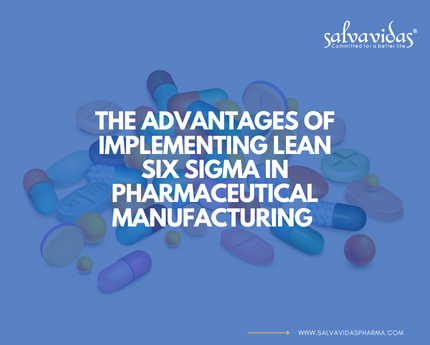
Introduction In the fast-paced and critically important world of pharmaceuticals, quality control, efficiency, and precision are paramount. This is where the concept of Six Sigma comes into play. Six Sigma is a data-driven methodology that focuses on eliminating defects and reducing variations in processes, ultimately leading to improved quality and increased efficiency. In the context of the pharmaceutical industry, the application of Six Sigma principles has been transformative, allowing companies to uphold the highest standards, meet regulatory requirements, and deliver safe and effective medications to patients worldwide. Six Sigma in Pharmaceutical Industry Six Sigma principles have found a significant foothold in the pharmaceutical sector due to the complex nature of drug development and manufacturing. By adhering to Six Sigma methodologies, pharmaceutical companies can streamline their operations, enhance product quality, and optimize resource allocation. The integration of Six Sigma in the pharmaceutical industry is a testament to its effectiveness in addressing challenges and ensuring patient safety. Enhancing Quality Control In an industry where even the slightest variation can have profound consequences, maintaining stringent quality control measures is imperative. Six Sigma provides a systematic approach to achieving this goal. By utilizing statistical analysis and process improvement techniques, pharmaceutical companies can identify and rectify quality issues early in the production process. This not only reduces the risk of product recalls but also fosters a culture of continuous improvement. Optimizing Manufacturing Processes Pharmaceutical manufacturing involves a multitude of intricate processes, each contributing to the final product. Six Sigma’s emphasis on process optimization has led to significant breakthroughs in this regard. By analyzing data and identifying inefficiencies, manufacturers can make informed decisions to streamline operations, reduce waste, and minimize production delays. This not only ensures timely delivery of medications but also enhances cost-effectiveness. Ensuring Regulatory Compliance Regulatory compliance is a cornerstone of the pharmaceutical industry, with agencies such as the FDA setting stringent guidelines to safeguard public health. Six Sigma’s methodical approach aligns seamlessly with regulatory requirements. Companies can use Six Sigma methodologies to establish robust processes that adhere to these guidelines consistently. This proactive approach not only expedites approval processes but also minimizes the risk of non-compliance issues. Empowering Data-Driven Decision Making In the pharmaceutical sector, decisions rooted in data and evidence are paramount. Six Sigma’s data-driven approach equips organizations with the tools to make informed choices. By collecting and analyzing data at every stage of drug development and manufacturing, companies can identify trends, predict potential challenges, and make necessary adjustments. This proactive decision-making contributes to the overall success of projects and reduces the likelihood of costly setbacks. Reducing Costs and Increasing Efficiency Cost containment is a challenge faced by many industries, and pharmaceuticals are no exception. Six Sigma’s core philosophy of reducing defects directly translates into cost savings. By minimizing errors and wastage, companies can allocate resources more efficiently and allocate saved funds toward research, development, and innovation. This holistic approach enhances competitiveness and accelerates progress. Promoting Cross-Functional Collaboration Successful pharmaceutical endeavors require seamless collaboration between various departments, from research and development to manufacturing and distribution. Six Sigma’s collaborative methodologies break down silos and promote cross-functional cooperation. Teams work together to identify and resolve challenges, share best practices, and collectively contribute to the achievement of organizational goals. Harnessing Technology and Automation The integration of technology and automation has revolutionized pharmaceutical processes. Six Sigma complements this transformation by ensuring that technological advancements align with quality and efficiency objectives. Whether it’s implementing automated quality control checks or utilizing data analytics for predictive maintenance, Six Sigma principles guide the integration of technology to enhance overall operations. Fostering a Culture of Continuous Improvement Six Sigma is more than just a methodology; it’s a philosophy that advocates for ongoing enhancement. In the pharmaceutical industry, where advancements can mean the difference between life and death, fostering a culture of continuous improvement is crucial. Six Sigma encourages employees at all levels to identify opportunities for refinement, propose solutions, and participate in the journey toward excellence. FAQs Q: How does Six Sigma benefit pharmaceutical companies?A: Six Sigma enhances pharmaceutical companies by improving quality control, optimizing manufacturing processes, ensuring regulatory compliance, empowering data-driven decisions, reducing costs, and promoting cross-functional collaboration. Q: Can Six Sigma be applied to drug research and development?A: Yes, Six Sigma principles can be applied to various stages of drug research and development, leading to more efficient and successful outcomes. Q: What role does data analysis play in Six Sigma for pharmaceuticals?A: Data analysis is a cornerstone of Six Sigma. It allows companies to identify patterns, trends, and areas for improvement, contributing to better decision-making and overall process enhancement. Q: Is Six Sigma a one-time implementation or an ongoing process?A: Six Sigma is an ongoing process. It encourages a culture of continuous improvement, with teams consistently identifying and addressing challenges to enhance processes. Q: Can small pharmaceutical companies benefit from Six Sigma?A: Absolutely. Six Sigma principles are scalable and can be adapted to the size and resources of the company, offering benefits to organizations of all scales. Q: How does Six Sigma contribute to patient safety?A: By minimizing defects and errors, Six Sigma directly contributes to the safety and efficacy of pharmaceutical products, ensuring that patients receive medications of the highest quality.

Introduction The pharmaceutical industry is one of the fastest-growing sectors in India, with a global reach that continues to expand rapidly. The industry has seen significant growth in recent years, with India being one of the largest exporters of generic drugs worldwide. In this context, packaging plays a crucial role in ensuring that the quality and efficacy of these drugs are maintained throughout the supply chain. This article will explore the critical role that packaging plays in the pharmaceutical manufacturing and export industry in India. Importance of Packaging in the Pharmaceutical Industry Protection of Pharmaceutical Products Safety of Patients Regulatory Compliance Branding and Marketing Types of Packaging Used in the Pharmaceutical Industry Primary Packaging Secondary Packaging Tertiary Packaging Packaging Requirements for Pharmaceutical Exports in India International Standards and Regulations Documentation and Labelling Requirements Climate and Temperature Control Challenges in Pharmaceutical Packaging and Export Counterfeiting and Piracy Cost and Affordability Technical and Operational Challenges Innovations in Pharmaceutical Packaging Smart Packaging Biodegradable Packaging Nanotechnology Bullet Points: Good quality packaging ensures that the drugs remain protected from external factors such as moisture, air, light, and temperature Packaging also plays a crucial role in protecting patients from counterfeit or substandard drugs Proper packaging helps in compliance with regulatory standards, which is essential for the pharmaceutical industry Branded packaging helps companies establish their identity in the market and increases their visibility and sales Primary packaging includes containers that come in direct contact with the drug, while secondary packaging refers to the outer packaging Tertiary packaging is used to protect the products during transportation and storage Pharmaceutical exports are subject to various international regulations, including the World Health Organization’s Good Manufacturing Practices (GMP) Exporters must provide accurate documentation and labelling to comply with international regulations Climate and temperature control during transportation is essential to ensure that the products remain effective and safe FAQs: Q. What are the most common types of packaging used in the pharmaceutical industry?A. The three most common types of packaging used in the pharmaceutical industry are primary, secondary, and tertiary packaging. Q. What are the international standards and regulations for pharmaceutical exports?A. The World Health Organization’s Good Manufacturing Practices (GMP) is the most widely recognized international standard for pharmaceutical exports. Q. What are some of the challenges faced by the pharmaceutical industry in packaging and exporting?A. Some of the challenges faced by the pharmaceutical industry include counterfeiting and piracy, cost and affordability, and technical and operational challenges. Conclusion: In conclusion, packaging plays a crucial role in the success of the pharmaceutical manufacturing and export industry in India. Good quality packaging protects the products from external factors and ensures their efficacy and safety. Compliance with international standards and regulations is essential for pharmaceutical exports. The challenges faced by the industry can be addressed through innovation and the adoption of new technologies. The pharmaceutical industry’s growth and success are heavily dependent on the quality of packaging, and it is essential to prioritize this aspect of the industry for the continued growth and success of the sector.

Introduction When it comes to pharmaceutical products, quality, and safety are non-negotiable. Patients rely on medications to help them heal, manage their conditions, and improve their quality of life. Therefore, pharmaceutical manufacturing companies have a crucial responsibility to ensure that their products are of the highest quality, from the ingredients to the packaging. While most people tend to focus on the ingredients and efficacy of medicines, the importance of good packaging in pharmaceutical manufacturing and export cannot be understated. In this article, we’ll explore the reasons why packaging plays a crucial role in the pharmaceutical industry, and why manufacturers need to invest in good packaging solutions. Why is good packaging important in pharmaceutical manufacturing and export? Packaging is not just a matter of aesthetics or convenience in the pharmaceutical industry. It serves many important functions, such as: Protection: Pharmaceutical products are vulnerable to various external factors such as moisture, light, and temperature. Good packaging protects the products from these factors, ensuring that the medicines remain safe and effective for the end-users. Tamper-evidence: Quality packaging can serve as a tamper-evident seal that alerts consumers and regulators if a product has been tampered with or opened. Compliance: The pharmaceutical industry is subject to strict regulatory requirements that govern everything from the ingredients to the packaging. Good packaging ensures that the products meet these regulations, avoiding costly recalls or penalties. Marketing: Packaging can also help to promote brand recognition, provide essential information about the product, and enhance the overall user experience. Challenges in pharmaceutical packaging Despite the many benefits of good packaging, there are also some challenges that pharmaceutical manufacturers face, such as: Cost: Quality packaging can be expensive, and manufacturers need to balance the cost with the benefits and regulatory requirements. Sustainability: Many pharmaceutical packaging materials, such as plastics, are not environmentally friendly, and manufacturers need to find sustainable alternatives. Innovation: With the rise of e-commerce, telemedicine, and personalized medicine, pharmaceutical manufacturers need to innovate and adapt their packaging solutions to meet the changing needs of the market. Best practices in pharmaceutical packaging To overcome these challenges and ensure that their products are safe, compliant, and effective, pharmaceutical manufacturers should follow these best practices: Choose the right materials: Consider the nature of the product, the storage conditions, and the regulatory requirements when selecting the packaging materials. Test and validate: Perform rigorous testing and validation to ensure that the packaging solution meets the intended purpose and regulatory requirements. Ensure sustainability: Explore sustainable alternatives and optimize the packaging design to minimize waste and environmental impact. Innovate and adapt: Stay abreast of the latest trends and technologies in packaging and continuously improve the packaging solutions to meet the changing needs of the market. FAQs Q: What are the most common packaging materials used in the pharmaceutical industry?A: The most common packaging materials in the pharmaceutical industry include plastic, glass, and metal. Q: How can packaging protect pharmaceutical products from external factors?A: Packaging can protect pharmaceutical products from external factors such as moisture, light, and temperature by providing a barrier between the product and the environment. Q: Why is tamper-evident packaging important in the pharmaceutical industry?A: Tamper-evident packaging is important in the pharmaceutical industry because it can alert consumers and regulators if a product has been tampered with or opened, ensuring that the product is safe and effective. Conclusion Good packaging is essential in pharmaceutical manufacturing and export to ensure the safety, efficacy, and compliance of pharmaceutical products. While the packaging may seem like a trivial aspect, it serves many vital functions, such as protecting the products from external factors, providing tamper evidence, ensuring compliance, and enhancing the user experience. Pharmaceutical manufacturers face many challenges in packaging, such as cost, sustainability, and innovation, but they can overcome these challenges by following best practices such as choosing the right materials, testing and validating, ensuring sustainability, and innovating and adapting. In conclusion, good packaging is not just a matter of aesthetics or convenience in the pharmaceutical industry. It is an essential component that can make a significant impact on the safety and efficacy of pharmaceutical products. By investing in quality packaging solutions, pharmaceutical manufacturers can uphold their responsibility to provide safe, effective, and compliant products to patients worldwide.

0